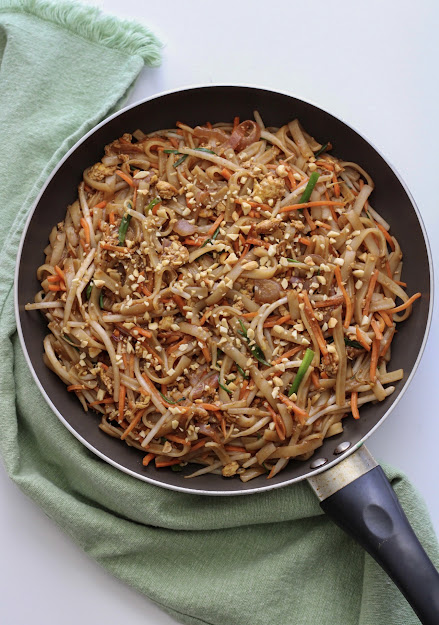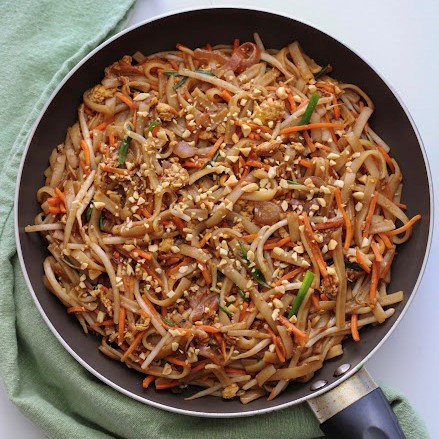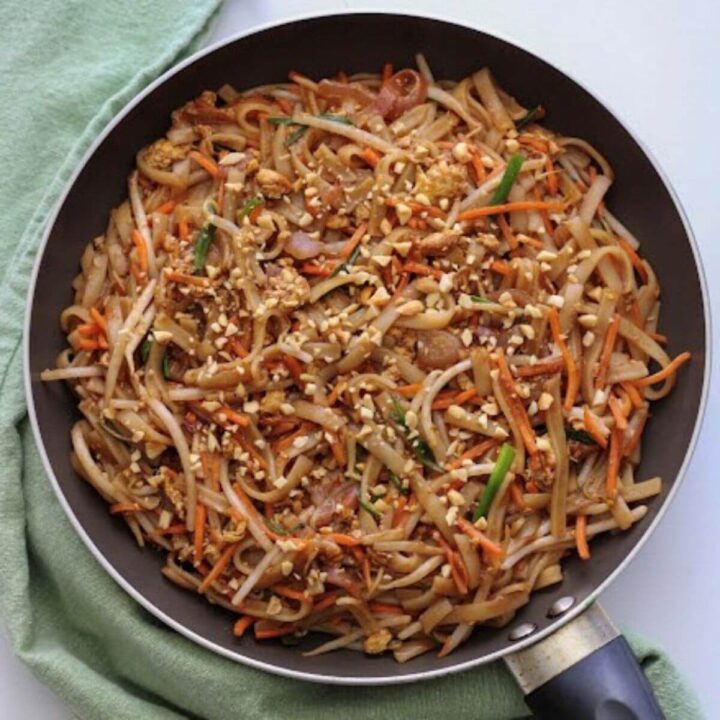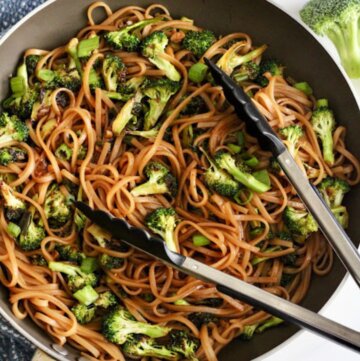This gluten-free pad thai recipe has delicious flavors right from Thailand! And it's one of the most popular recipes on the blog. I hope you love it too!
This post may contain affiliate links. Please see my disclosure page for more information. Thanks!

About This Pad Thai Recipe
I learned to cook pad thai at Mama Noi Thai Cookery School in Chiang Mai, Thailand in March of 2019. Once we returned home from our trip around the world, I was determined to recreate my own gluten-free version of the dish I loved eating in Thailand.
With some inspiration from our days at the cooking school, and paying homage to Pink House (the now-closed gluten-free restaurant where I had my first bite of pad thai - ever), that's what you'll find here in this travel-inspired recipe. This is not authentic, but my take or version on pad thai using the techniques I learned in Thailand with gluten-free ingredients.
Want to visit Thailand with celiac disease? It's tricky, but not impossible. Here's my full guide for eating gluten-free in Thailand.
Is Pad Thai normally gluten-free?
No, it is not. While the noodles are rice based, the sauces, such as soy sauce and oyster sauce usually contain gluten, which means pad thai is most often not safe for celiacs to consume. You'll need to check with the chef if you see this on a restaurant menu to confirm the ingredients and preparation are gluten-free.
For this recipe, you'll be making your own pad thai sauce using gluten-free sauces and ingredients.
Ingredients You Need For Gluten-Free Pad Thai
You can customize this dish however you like - feel free to add meat (or don't), stick to a vegetarian version with tofu, or just add eggs. I only add an egg or two to pad thai because it's exactly how I ordered it in Thailand. I'm a sucker for tradition, you could say!
Rice Noodles: Be sure to soak them first. I use Taste of Thai!
Eggs: The main protein in our dish. You can also use tofu, or add an additional protein like chicken or shrimp.
Water: This will help form the sauce.
Shallots: Shallots are in the onion family, but are smaller and a red/purple color.
Chives: Use fresh chives, not dried ones.
Bean Sprouts: One of the fillings for pad thai, and something we always had in Thailand.
Shredded Carrots: You can buy them pre-shredded, or use a vegetable peeler to make long strips yourself.
Vegetable Oil: To cook the pad thai, we'll use vegetable oil, but you can sub whatever oil you prefer.
Pad Thai Sauce: This recipe does NOT use a pre-made pad thai sauce, but one that is made from scratch. I have linked the brands of gluten-free soy, fish, and oyster sauce for you here if you can't find them in your grocery store.
-Coconut Sugar
-Chili Powder
-Gluten-Free Soy Sauce
-Gluten-Free Fish Sauce
-Gluten-Free Oyster Sauce
-Tamarind Paste or Concentrate
Chopped Peanuts & Fresh limes: My go-to toppings for pad thai in Thailand were a big scoop of chopped peanuts and lots of fresh lime juice. You can also try red pepper flakes for an extra kick!
Frequently Asked Questions
Can I make this dairy-free too?
Yes! This pad thai recipe is gluten and dairy-free already. You don't need to modify or change anything.
Can I make this recipe vegetarian?
Absolutely! Just substitute tofu for your protein. I only use egg when making pad thai because it's how I traditionally ate it in Thailand.
What is Tamarind Paste?
Tamarind paste or concentrate is a sweet & sour paste made from tamarind fruit. It's a popular ingredient in Asian cooking, and you can find it in the Asian foods section of your grocery store. If you are unable to find tamarind paste/concentrate, you can substitute it with lime juice or a combination of sugar and vinegar. Check out this article which discusses the best substitutes.
How To Make Pad Thai

Pad thai is not a complicated dish but does require a lot of stirring and quick attention. The dish moves fast so make sure you pay attention!
After soaking the rice noodles to soften them and making the sauce, you'll fry the shallots in oil and add the eggs, followed by the noodles and sauce.
The water will thicken the sauce and the noodles will absorb it. At the very end, the chives, carrots, and beans sprouts go in for a few seconds, and then it's done!
Watch the step-by-step video right here for how to make it!
How to Serve Pad Thai
I always serve pad thai with 3 finishing toppings: chopped peanuts, fresh limes for squeezing, and for extra spice, red pepper flakes. These were presented to us when we ordered pad thai from a gluten-free restaurant in Thailand in 2019 (now closed, sadly), and that's how I continue to serve and eat it at home.
How To Store Pad Thai
Pad Thai should be stored covered in the refrigerator. You can reheat in the microwave or on the stovetop for a few minutes. Pro tip: Add a tablespoon or two of unsalted butter when reheating. Trust me!
Every time I take a bite of these gluten-free pad thai noodles, I'm transported back to Thailand - wandering the temples with Dylan and grabbing nighttime fruit smoothies to stay cool in the 100-degree heat. The flavors of the pad thai sauce (made from scratch, not a jar!), combined with the sauteed noodles, chopped peanuts, and a squeeze of fresh lime juice, are a guaranteed hit of nostalgia for Southeast Asia.

Looking for more travel-inspired recipes?
Try these homemade gluten-free croissants with a cup of coffee. Pretend you're in Paris having breakfast along the Seine. Dreamy!
Feel like a project? Make these gluten-free beef and cheese empanadas inspired by our time in Argentina. Yum!
Did you know the potato is on of the most common ingredients in Peruvian dishes? They grow over 4,000 different kinds! Try them in lomo saltado - a Peruvian stir fry, with beef, tomatoes, and french fries.
Here's how to make this travel-inspired dish: gluten-free, pad thai!
If you love this recipe, please leave a comment! Thank you so much!
Gluten-Free Pad Thai Recipe

Gluten-Free Pad Thai
The best gluten-free pad thai recipe! With flavors right from Thailand!
Ingredients
- 8 ounces (roughly 200 grams) rice noodles, soak first
- 2 eggs
- 1 cup of water (this is for the sauce, not for soaking noodles.)
- 2-3 small shallots, sliced thin
- 7-8 fresh chives, cut into thirds
- ⅓ cup of bean sprouts
- ⅓ cup of carrots, shredded
- 2 Tablespoons vegetable oil, or cooking oil of choice
- 1 tablespoon coconut sugar
- 1 tablespoon gluten-free fish sauce
- 1 tablespoon gluten-free soy sauce
- 2 Tbsps gluten-free oyster sauce
- 2 Tbsps tamarind paste/sauce (see note)
- 1 teaspoon chili powder
- sliced limes, chopped peanuts, for serving
- Optional: chicken or tofu, cubed
Instructions
Prep everything beforehand so you are ready to go when you start cooking. Pad Thai moves fast! You want to have your meat/vegetables chopped, seasoning sauce mixed, and noodles soaked before you begin cooking.
Follow package instructions to soak or boil rice noodles. Drain and set aside when soft.
Combine the coconut sugar, gluten-free fish sauce, gluten-free soy sauce, gluten-free oyster sauce, tamarind paste, and chili powder in a small bowl and whisk to combine. Set aside.
Bring all ingredients close to your stovetop so everything is easily accessible. Heat oil in wok/frying pan over medium heat.
Toss in the shallots and fry until fragrant, but be careful not to burn. Crack the egg directly into the pan, using your spatula or spoon to scramble it and mix in with other ingredients. Once it is completely scrambled, push everything in the pan to one side, allowing free space.
In the free space you have created, add the drained rice noodles, seasoning sauce, and ½ cup of the water. Stir and mix well, allowing the sauce to coat the noodles completely. Cook according to package directions for noodles to become tender (usually about 5 minutes). Add in the other ½ cup of water slowly when you notice noodles begin to stick to the pan and the liquid absorbed.
Almost there! Keep stirring! Lastly, add the bean sprouts, chives, and carrots, and stir everything for a few more seconds. Remove from heat, and it’s done!
Garnish your gluten-free pad thai with chopped peanuts and fresh lime juice. If you like, add some red pepper flakes for a little spice, and cilantro just for decoration.
Notes
Meat: Optional
This dish can be altered to suit your dietary preferences and needs. The most common way I had pad thai in Thailand was just with egg. You can also add chicken or tofu for extra protein. Cook it at the beginning along with the shallots and eggs.
Noodles
Make sure to soak or pre-boil the rice noodles first. Follow the package directions. It normally takes about 20 minutes so this should be your first step (see step 1)! You will sauté them to finish cooking.
Tamarind Sauce/Paste
Tamarind is a sour fruit that is common in Thai cooking. It’s made into a paste that gives food a really sweet yet sour flavor. If you are unable to find Tamarind Sauce, you can substitute with lime juice or a combination of sugar and vinegar. Check out this article which discusses the best substitutes.
*PRO TIP: When reheating, add 1 tablespoon butter (dairy-free if needed) for extra flavor. Trust me.
Nutrition Information
Yield 4 Serving Size 1Amount Per Serving Calories 677Total Fat 20gSaturated Fat 3gTrans Fat 0gUnsaturated Fat 15gCholesterol 114mgSodium 1055mgCarbohydrates 97gFiber 8gSugar 12gProtein 28g
The nutrition information on each recipe card is provided as a courtesy and for your convenience. The data is calculated by Nutritionix. You are encouraged to make your own calculations based on your ingredients and preferred nutritional facts calculator. While I try to make sure they are accurate, I cannot guarantee the accuracy of these calculations.
Have you ever been to Thailand?
Did you make this pad thai recipe?
Let me know in the comments below!





Justine Fiscus says
What tamarind paste/sauce do you use? The Asian market I went to only had one brand and wasn’t labeled GF so I didn’t trust it.
Jennifer Fitzpatrick says
Hi Justine! I know Pure Indian Foods has GF on the label of its Tamarind. In general, tamarind should only contain The tamarind fruit and water. I hope that helps! I’m currently out of stock in my pantry and need to get more!
Kristina says
LOVE this recipe! It's becoming a staple of mine :). Thank you, Jen!
Jennifer Fitzpatrick says
YAY! I'm so glad, Kristina. Thank you for sharing!